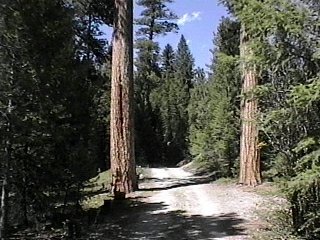Magnificient Ponderosa pine

Ponderosa pine stand as forest guards
There are few trees, IMHO, more beautiful than the Ponderosa pine. I have read the Ponderosa pine outlines the “real” American West. If you’re driving through the high desert of the Southwest, the towering mountains of Colorado, or watching an old episode of Bonanza on tv, the tree youare most likely seeing is the Ponderosa pine. No doubt about it, the signature tree of the mountain West is the Ponderosa pine.
The Ponderosa pine is prolific.
Hike anywhere in Arizona’s Coconino National Forest and you are hiking through these trees. You don’t have to look hard in where in the West for them — they’re everywhere. (Northern Arizona’s national forests boast of having the largest continuous stand of these magnificent trees in the world.)
As prolific as Ponderosas are, there’s still a lot that scientists don’t know about them. For example, they change color as they get older. “Early lumbermen who came out here thought they were two different species,” says Steve Hirst of the U.S. Forest Service. The trees with black bark were called black jack pine, those with yellow bark (which are the older trees) were called yellow pine but both are Ponderosa pines.
Identiying these magnificant trees
Two aids in recognizing a Ponderosa pine is their needles grow in clusters of three (like the three “boys” in Bonanza, Adam, Hoss, and Little Joe) and their pine cone will be prickly your hand when you hold them tight.
When the tree reaches 110 to 120 years old (a teenager for a Ponderosa pine), it begins to shed its black bark and reveal an inner bark of yellow. That’s why some call them “Yellowbellies.” Scientists still don’t know why this happens.
There’s something else that begins to happen to the tree in its yellowbelly phase. It begins to smell like butterscotch or vanilla. Unfortunately, the next person who smells it may insist it’s more like cinnamon, or even coconut. Scientists don’t know why a closely sniffed Ponderosa smells like baking cookies. But they think the aroma may arise from a chemical in the sap warmed by the sun.
When you stick your nose deep into a Ponderosa, you’re also getting intimate with the tree’s armor against fires: bark that is thick, flaky and sometimes compared to pieces of a jigsaw puzzle. The tree needs that protective layer especially from lightning strikes, a common occurrence in the land of the Ponderosa pine.
Fire retarting tree
Another interesting feature of the Ponderosa pine is that lightning isn’t enough to finish off. When lightning hits one, “it flash-boils the sap, and it just blows the bark off. It doesn’t burn the tree,” Hirst explains. When the pieces of bark fly off, they carry away the fire’s heat. So a major fire can leave “the Ponderosas in charge” of a forest, and they remain standing while the competition burns.
However, an intense fire (a fire burning a large amount of “fuel” concentrated on the ground) can “ladder up” to the crowns of the Ponderosas. When the crowns of the tree burn, the tree is lost and the fire can hop-scotch to neighboring trees. Then the entire stand might be lost.
To minimize the potential destruction from fire the U.S. Forest Service, working with environmental groups and timber companies, is thinning out trees and setting prescribed fires, so the Ponderosas pine can continue to reign over the American West.


